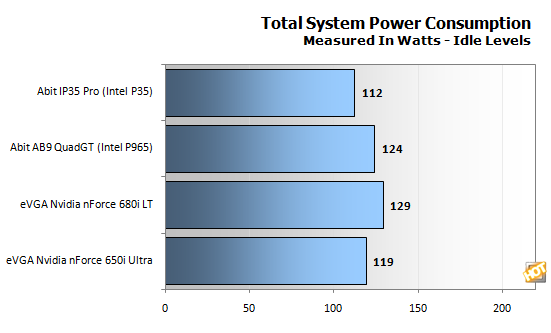Abit IP35 PRO P35 and AB9 QuadGT P965 Motherboards
BIOS, Overclocking, and Power Consumption
Both the IP35 Pro and the AB9 QuadGT use BIOS technology from Phoenix, and in typical Abit fashion, quite a bit has been added to the stock BIOS menu in order to make them unique. Both boards feature Abit’s own onboard uGuru system monitoring chip onboard, which allows for more flexible overclocking, fan controls, and thermal sensing. Abit keeps all of their custom BIOS options in a separate menu for ease of use purposes. As you would expect from modern day Abit motherboards, you have full control over voltage levels and timing controls, giving plenty of overclocking functionality without getting too overly technical.
One of the core differences between the BIOSes which we noticed is that the newer IP35 Pro platform supports a wider range of memory speeds in comparison to the AB9 QuadGT. As the IP35 Pro has official support for 1333 MHz FSB speeds (and since memory speeds are tied to front side bus speeds on Intel based chipsets), the IP35 Pro has to support additional memory divisors in order to run memory modules properly. However, even if you’re not using a 1333 MHz FSB based processor, you can still benefit from additional memory flexibility on this board.
With identical hardware configurations and cooling, we set out to see which platform could overclock better with our 2.4 GHz Intel Core 2 Duo E6600 processor. We’ve seen Nvidia platforms take this chip up to 490 MHz FSB (1960 MHz FSB quad-pumped), although since Nvidia platforms can run the FSB independent from the memory bus, they have an inherent advantage. With our new P35 Express platform, we were able to take our chip nearly as high, topping out at 466 MHz FSB (1866 MHz FSB quad-pumped) speed. Our P965 platform undortunately did not fare as well, as the board topped out at 425 MHz FSB (1700 MHz FSB quad-pumped). While both are healthy overclocks, we were a bit surprised at how low our AB9 QuadGT overclocks were, considering how the P965 has been an excellent overclocker in the past.

Overclocked on IP35 Pro - 1866 MHz FSB |

Overclocked on AB9 QuadGT - 1700 MHz FSB |
We were also curious to see if there were any major differences in terms of power consumption between these two boards. Thus, we set them up with identical configurations (2.4 GHz Core 2 Duo, 2 GB memory, Radeon X1950 Pro graphics) with the same PSU and other hardware, and watched power usage levels on a watt meter. Here are our results.


In both cases, we found that Abit’s newer IP35 Pro (P35 Express) consumed less power (about 12W) in comparison to the AB9 QuadGT (P965). With lower power consumption, we also have less heat production, which leads to overall cooler and quieter system configurations. The IP35 Pro consumes about as much power as Nvidia’s 650i Ultra platform, which has a similar feature set to the IP35, and also runs with passive cooling.






